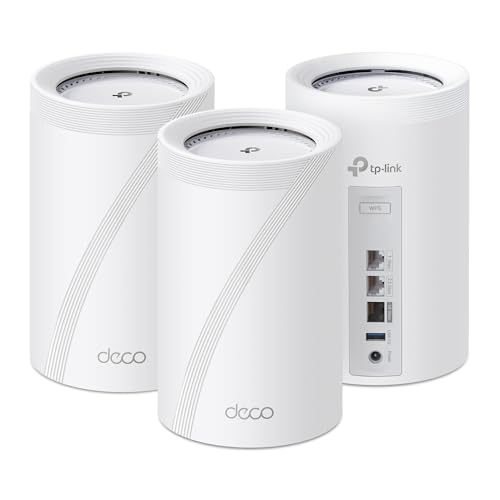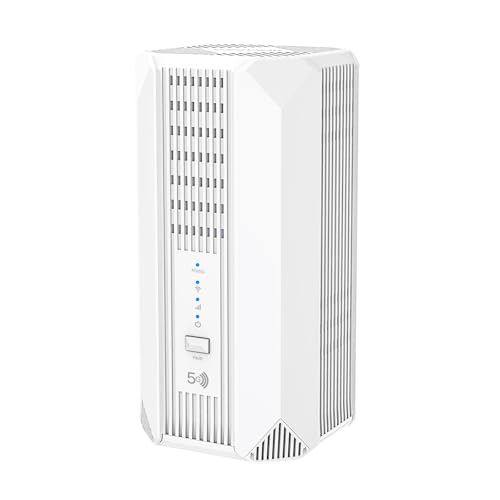Best 5g Sim Router Reviews & Buyer's Guide in 2026
Mike Kim Jan 7, 2026 2:33 AM
In the era of lightning-fast connectivity, the search for the best 5G SIM router has become imperative for those seeking seamless internet access on the go. Whether you're a digital nomad, a remote worker, or simply someone who craves high-speed internet wherever you are, finding the right 5G SIM router can elevate your online experience to new heights. Join us as we embark on a journey to uncover the top contenders in the market, exploring their features, performance, and compatibility. Get ready to harness the power of 5G connectivity with the perfect SIM router tailored to meet your needs.
Top Picks
Source: Amazon
Best 5G Mobile Hotspot: NETGEAR Nighthawk M6 5G Mobile Hotspot
Pros:
-
High-speed 5G connectivity
-
WiFi 6 support
-
Connects up to 32 devices
-
Long-lasting battery
Cons:
-
Limited to tablet compatibility
-
Bulky for pocket use
The NETGEAR Nighthawk M6 combines 5G and WiFi 6 technology to deliver fast, secure internet both at home and on the go. Its ability to connect up to 32 devices simultaneously makes it ideal for families or small office setups. The device can function as a primary home internet source, a backup during outages, or a mobile hotspot, offering versatile connectivity. Users can swap SIM cards easily, and the removable battery plus power adapter option extends coverage up to 2,000 sq. ft. for stationary use.
From a customer perspective, the Nighthawk M6 is praised for its reliable speed, strong security features, and ease of use. Some note its size can be less convenient for constant travel, and compatibility is limited to certain devices. Overall, it is considered a robust solution for those seeking flexible, high-performance mobile internet without depending solely on a smartphone hotspot.
Best 5G Router: Cudy New 5G NR SA NSA AX3000 WiFi 6
Pros:
-
Ultra-fast 5G and WiFi 6 speeds
-
Dual SIM with WAN failover
-
Multiple VPN support
-
High-performance CPU
Cons:
-
T-Mobile SIM not compatible
-
Heavier than typical mobile routers
The Cudy P5 is a high-performance dual-band router designed for users seeking fast, reliable internet through 5G and WiFi 6. Equipped with a Qualcomm SDX62 5G modem and a 1 GHz dual-core ARM Cortex-A53 CPU, it delivers downlink speeds up to 2.5 Gbps on 5G and up to 1 Gbps on 4G LTE, while WiFi speeds reach 3000 Mbps across both bands. Its dual SIM slot and WAN failover ensure uninterrupted connectivity, and replaceable antennas enhance signal strength and coverage. The router also supports multiple VPN protocols, making it suitable for remote work, cameras, and secure network management.
Customers generally appreciate its impressive speed, robust connectivity, and VPN flexibility. Some note the heavier design and T-Mobile SIM incompatibility as minor drawbacks. Overall, the Cudy P5 is seen as a versatile solution for high-speed home or office networking with advanced remote access capabilities.
Best 5G VPN Router: GL.iNet GL-X3000 (Spitz AX) Cellular Gateway 5G Router
Pros:
-
Fast WiFi 6 with MU-MIMO
-
Dual SIM with automatic failover
-
Pre-installed OpenVPN and WireGuard
-
Customizable OpenWrt firmware
Cons:
-
VPN speeds lower than raw WiFi speed
-
Bulkier setup for mobile use
The GL.iNet Spitz AX (GL-X3000) is a dual-band 5G cellular router designed for business and remote access, offering fast WiFi 6 performance with speeds up to 574 Mbps on 2.4 GHz and 2402 Mbps on 5 GHz. Its dual SIM capability ensures reliable connectivity with automatic failover between ISPs, while multi-WAN support allows flexible bandwidth management through Ethernet, cellular, tethering, or repeater connections. Pre-installed OpenVPN and WireGuard support secure networking for up to 30+ VPN services, and the router’s OpenWrt-based firmware provides extensive customization options.
From a customer perspective, the Spitz AX is praised for its versatility, robust connectivity, and VPN security features, particularly for remote offices, RVs, or mobile work environments. Users note that while VPN speeds are slower than the maximum WiFi throughput and the device setup can be bulkier, it remains a dependable solution for advanced networking needs with strong security and connectivity stability.
Best Travel Hotspot: SIMO Solis 5G WiFi Mobile Hotspot for Travel
Pros:
-
Global multi-carrier coverage
-
Connects up to 16 devices
-
Long-lasting 24-hour battery
-
Built-in power bank functionality
Cons:
-
Limited included data (1GB/month)
-
Dependent on app for setup
The SIMO Solis Go + Data is a portable dual-band WiFi hotspot designed for travelers and remote workers who need reliable internet worldwide. Supporting connections to over 300 carriers across 140+ countries, it allows up to 16 devices to connect simultaneously. The device comes with a built-in 24-hour battery and functions as a power bank, ensuring that your devices remain charged on the go. A 1GB monthly data allowance is included for the lifetime of the unit, with additional data options available, and setup is managed through the dedicated Solis app.
From a customer perspective, the Solis Go + Data is praised for its global connectivity, portability, and convenience for travel or remote work. Some users note that the included data is minimal and reliance on the app can be a limitation, but overall it is valued as a versatile, easy-to-use solution for secure internet access anywhere.
Best 5G Business Router: GL.iNet GL-XE3000 (Puli AX) 5G Router with Dual SIM
Pros:
-
Fast WiFi 6 with MU-MIMO
-
Dual SIM with automatic failover
-
Built-in 6400mAh battery
-
Pre-installed OpenVPN and WireGuard
Cons:
-
Limited VPN speeds compared to WiFi
-
Heavier than typical mobile routers
The GL.iNet Puli AX (GL-XE3000) is a dual-band 5G cellular router designed for business, gaming, home, and mobile setups like RVs. It delivers WiFi 6 speeds up to 574 Mbps on 2.4 GHz and 2402 Mbps on 5 GHz, supporting MU-MIMO for multiple simultaneous connections. Dual SIM slots with automatic failover ensure stable connectivity, while a built-in 6400mAh battery provides up to 8 hours of uninterrupted use. Pre-installed OpenVPN and WireGuard VPNs support secure remote access, and multi-WAN options with load balancing allow reliable connections across Ethernet, cellular, tethering, and repeaters.
From a customer perspective, the Puli AX is valued for its versatility, stable 5G performance, and secure connectivity for both professional and personal use. Some users note that VPN speeds are slower than maximum WiFi throughput and the device’s weight may limit portability, but overall it is praised as a dependable solution for businesses, remote work, and mobile operations.
- 9.4
- BrandSIMO
- Prime
- 9.2
- BrandGL.iNet
- 9.0
- BrandKuWFi
- 8.9
- BrandCudy
- 8.7
- BrandSquareWiz
- 8.5
- BrandUOTEK
- Prime
- 8.3
- BrandUOTEK
- Prime
Last update on 2026-01-07 / Affiliate links / Images, Product Titles, and Product Highlights from Amazon Product Advertising API
Yes, you can use a 5G SIM card in a compatible router that supports 5G connectivity. With the emergence of 5G technology, routers equipped to accept 5G SIM cards have become increasingly available in the market. These routers are specifically designed to leverage the high-speed, low-latency capabilities of 5G networks, providing users with fast and reliable internet connectivity.
Using a 5G SIM card in a router allows you to access the 5G network provided by your mobile service provider, offering potential benefits such as:
Faster Speeds: 5G networks can deliver significantly faster internet speeds compared to 4G LTE, allowing for smoother streaming, faster downloads, and improved overall performance.
Lower Latency: 5G networks typically offer lower latency, resulting in reduced lag and faster response times for online gaming, video calls, and other real-time applications.
Enhanced Reliability: 5G networks are designed to provide more reliable connectivity, even in densely populated areas or areas with high network congestion.
Greater Capacity: 5G networks have the potential to support a larger number of connected devices simultaneously, making them suitable for homes or offices with multiple users and IoT devices.
When using a 5G SIM card in a router, it's essential to ensure that the router is compatible with the specific 5G frequency bands used by your mobile service provider. Additionally, you should consider factors such as coverage, data plans, and any potential data caps or limitations imposed by your service provider.
Overall, using a 5G SIM card in a compatible router can provide you with access to high-speed internet connectivity, enabling you to enjoy a seamless online experience whether you're at home, in the office, or on the go.
Do you need a 5G router for a 5G SIM?
Yes, you typically need a 5G router specifically designed to support 5G connectivity if you intend to use a 5G SIM card.
5G technology operates on different frequency bands and utilizes different modulation techniques compared to previous generations of cellular technology like 4G LTE. As a result, routers must be designed and equipped to work with the unique characteristics of 5G networks in order to provide seamless connectivity and optimal performance.
Here are a few reasons why a 5G router is necessary for using a 5G SIM card:
Compatibility: 5G routers are designed to be compatible with the specific frequency bands and modulation schemes used by 5G networks. They are equipped with the necessary hardware and firmware to ensure reliable connectivity and high-speed data transmission over 5G networks.
Antenna Design: 5G routers are often equipped with advanced antenna designs optimized for 5G frequencies, allowing for improved signal reception and transmission. These antennas are crucial for maximizing coverage and ensuring a stable connection in various environments.
Performance: 5G routers are capable of leveraging the full potential of 5G technology, offering faster speeds, lower latency, and greater network capacity compared to routers designed for older cellular technologies. They are equipped with advanced features such as beamforming, MU-MIMO, and OFDMA to optimize performance and enhance the overall user experience.
Network Management: 5G routers typically come with advanced network management features that allow users to monitor and control their internet connection more effectively. They may offer features such as Quality of Service (QoS) settings, parental controls, and traffic prioritization to ensure a seamless online experience for all users.
In summary, while it is technically possible to use a 5G SIM card with a compatible device like a smartphone or mobile hotspot, using a dedicated 5G router is recommended for optimal performance, compatibility, and reliability when connecting multiple devices or establishing a fixed wireless broadband connection.
Is 5G router better than 4G?
Whether a 5G router is better than a 4G router depends on your specific needs and circumstances. Here are some factors to consider when comparing 5G and 4G routers:
Speed: Generally, 5G offers significantly faster speeds compared to 4G. 5G technology can potentially deliver multi-gigabit per second speeds, whereas 4G typically offers lower maximum speeds, usually up to a few hundred megabits per second. If you require high-speed internet for tasks like streaming 4K video, online gaming, or large file downloads, a 5G router may be preferable.
Latency: 5G networks typically have lower latency compared to 4G, meaning there is less delay between sending and receiving data. This can be advantageous for real-time applications like online gaming, video calls, and IoT devices that require quick response times.
Coverage: While 5G networks are expanding rapidly, their coverage may still be limited in some areas compared to 4G. If you live or work in an area with extensive 5G coverage, a 5G router can provide faster and more reliable internet access. However, if 5G coverage is limited in your area, a 4G router may be a more practical choice.
Network Capacity: 5G networks are designed to support a larger number of connected devices simultaneously compared to 4G. If you have multiple devices connected to your router or need to support a busy network with many users, a 5G router may offer better performance and reliability.
Future-Proofing: Investing in a 5G router may provide better long-term value as 5G networks continue to expand and evolve. As more 5G infrastructure is deployed, you may benefit from faster speeds and improved performance over time.
Ultimately, the decision between a 5G and 4G router depends on your specific requirements, budget, and the availability of 5G coverage in your area. If you prioritize speed, low latency, and future-proofing, a 5G router may be the better choice. However, if 5G coverage is limited or you don't require the fastest speeds, a 4G router may be sufficient for your needs.
Read More:
- 10 Best Router Under 2500 - Buyer’s Guide | SHR
- 10 The Best Router For Office Use We've Tested | SHR
- 10 Best Wifi Router Under 1500: Reviewed By SHR
- 10 The Best Vdsl Modem Router: Reviews By Expert
- The Best Cable From Phone Socket To Router: Top Rate Reviews in 2026
In conclusion, choosing the best 5G SIM router can transform your home or office network, delivering faster speeds, lower latency, and more reliable connectivity than traditional options. By evaluating performance, coverage, and additional features like security and multi-device support, you can ensure your investment meets both current and future networking needs. With the right 5G SIM router, seamless streaming, online gaming, and remote work become effortless, making it a vital tool for anyone looking to stay connected in today’s fast-paced digital world.






























